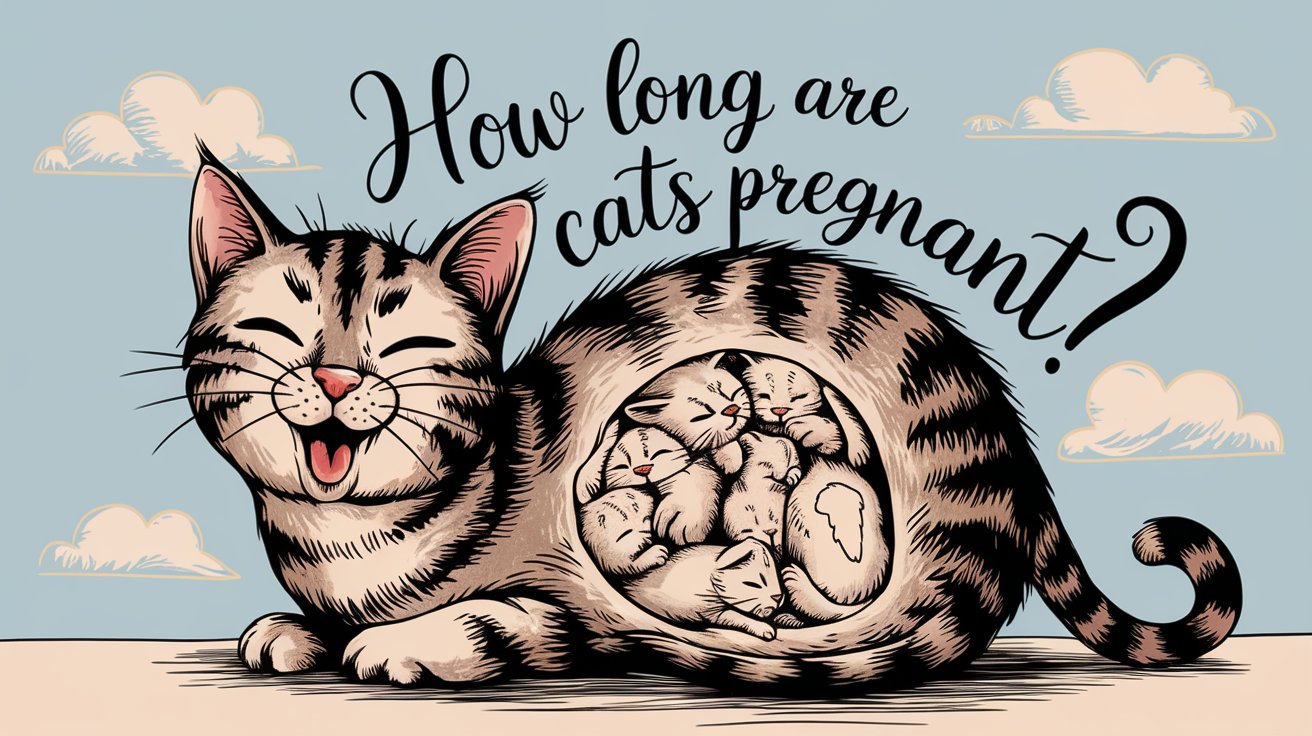
How Long Are Cats Pregnant?
A common question is how long cats are pregnant, you’re not alone. Knowing the length of a cat’s pregnancy is important for anyone who owns or cares for a cat. On average, a cat’s pregnancy lasts about 63 to 65 days, which is a little over two months. However, this timeframe can vary slightly depending on several factors, such as the cat’s age, health, and the size of the litter. Understanding how long cats are pregnant can help you provide the best care for your cat during this critical period.
The duration of a cat’s pregnancy is an essential part of feline reproduction. From the moment a cat conceives until the day she gives birth, the entire process is carefully timed to ensure the healthy development of the kittens. The gestation period—another term for pregnancy length—is typically divided into three trimesters, each lasting about three weeks. During this time, the kittens grow and develop inside the mother, preparing for their arrival into the world.
Now that we’ve covered the basic length of a cat’s pregnancy, let’s dive deeper into what happens during each stage of pregnancy, the signs of pregnancy, and how to care for a pregnant cat.
Understanding the Feline Reproductive Cycle
The Heat Cycle in Cats
Before a cat becomes pregnant, she goes through what is known as the heat cycle, or estrus. This is when a female cat is fertile and ready to mate. A cat’s heat cycle can occur as often as every two to three weeks during the breeding season, which typically lasts from early spring to late fall. Signs that a cat is in heat include increased vocalization, restlessness, and rubbing against objects more frequently.
Mating Behavior and Conception
When a female cat mates during her heat cycle, the chances of conception are very high. Once the cat has mated, the fertilized eggs will travel to the uterus, where they will implant and begin developing into embryos.
How Long Are Cats Pregnant?
Average Length of Cat Pregnancy
So, how long are cats pregnant? The average length of a cat’s pregnancy is about 63 to 65 days. This means that from the time of conception to the time of birth, it takes roughly two months for the kittens to develop fully. However, it’s not uncommon for some cats to give birth a few days earlier or later than this average timeframe.
Variations in Pregnancy Duration
While 63 to 65 days is the typical length, some cats may have shorter or longer pregnancies. Some may give birth as early as 58 days or as late as 72 days. If your cat is pregnant for more than 72 days, it’s important to consult with a veterinarian to ensure everything is progressing normally.
Factors Influencing Pregnancy Length
Several factors can influence the exact duration of a cat’s pregnancy. For instance, the number of kittens in the litter can play a role; cats carrying larger litter may give birth a little earlier. The mother cat’s age and health can also affect the pregnancy length. Younger and healthier cats tend to have more predictable pregnancies, while older cats or those with health issues might experience slight variations.

Stages of Cat Pregnancy
Understanding the stages of a cat’s pregnancy can help you know what to expect and how to care for your cat during this time.
The First Trimester (Weeks 1-3)
In the first trimester, the fertilized eggs implant in the uterus, and the embryos start to develop. Although it might not be obvious that your cat is pregnant at this stage, there are some early signs to look out for.
Early Signs of Pregnancy
During the first few weeks, you may notice subtle changes in your cat, such as a slight increase in appetite and a decrease in activity levels. Her nipples might also become slightly larger and pinker—a phenomenon known as “pinking up.”
The Second Trimester (Weeks 4-6)
As the pregnancy enters the second trimester, the kittens begin to grow more rapidly. By this stage, you’ll likely notice that your cat’s belly is starting to swell.
Developmental Milestones of Kittens
During these weeks, the kittens’ organs begin to form, and their skeletal systems start to develop. By the end of the second trimester, you may even be able to feel the kittens moving inside your cat’s belly, which is an exciting sign of their progress.
The Third Trimester (Weeks 7-9)
In the final trimester, the kittens are almost fully developed and getting ready for birth. Your cat’s belly will be quite large, and she may start to show signs that she’s preparing for labor.
Preparing for Birth
As the due date approaches, your cat will likely begin to exhibit nesting behavior. She might seek out a quiet, safe place to give birth and spend time arranging blankets or towels to create a comfortable space.

Signs That Your Cat Is Pregnant
Recognizing the signs of pregnancy in a cat is important for providing the right care.
Physical Changes in Pregnant Cats
Physical signs of pregnancy include a growing belly, enlarged and pink nipples, and a general increase in weight. Your cat’s abdomen will become more rounded as the kittens grow, and you might notice her eating more than usual.
Behavioral Changes in Pregnant Cats
Pregnant cats may also exhibit changes in behavior. Some become more affectionate and seek out more attention from their owners, while others might prefer solitude. It’s also common for a pregnant cat to become more protective of her space, especially as the due date gets closer.
Caring for a Pregnant Cat
Proper care is crucial to ensuring a healthy pregnancy for your cat.
Nutrition for Pregnant Cats
Pregnant cats need a balanced diet rich in protein, vitamins, and minerals to support their health and the development of their kittens. High-quality cat food formulated for pregnant and nursing cats is ideal. You may need to increase the amount of food you provide as the pregnancy progresses.
Veterinary Care During Pregnancy
Creating a Safe Environment
It’s important to create a calm and safe environment for your pregnant cat. Make sure she has a peaceful, cozy spot where she can relax without being disturbed. As the due date approaches, prepare a nesting area where she can give birth.
Preparing for the Birth
Knowing what to expect as your cat’s due date nears can help you prepare for the arrival of kittens.
Signs of Impending Labor
Signs that your cat is about to go into labor include restlessness, a drop in body temperature, and a decrease in appetite. She may also spend more time in her nesting area and become more vocal.
Setting Up a Nesting Area
Prepare a nesting area for your cat in a quiet part of your home. Use a box or crate lined with soft blankets or towels to create a comfortable, draft-free space where she can give birth.
What to Expect During Labor
Labor in cats usually occurs in three stages: the dilation of the cervix, the delivery of the kittens, and the expulsion of the placenta. The process can take several hours, depending on the number of kittens and the individual cat.
Post-Birth Care
Once the kittens have arrived, your focus will shift to caring for the mother and her new litter.
Caring for the Mother Cat
After giving birth, your cat will need plenty of rest and proper nutrition. Ensure she has access to fresh water and high-quality food, and provide a clean, comfortable space where she can nurse her kittens.
Caring for Newborn Kittens
Newborn kittens are entirely dependent on their mother for warmth, nutrition, and care. Monitor them to ensure they are nursing and gaining weight, and keep the nesting area clean and warm.
Recognizing Postpartum Complications
While most cats recover smoothly after giving birth, it’s important to be aware of potential complications such as excessive bleeding, infection, or mastitis.

Common Questions About Cat Pregnancy
How to Tell If a Cat Is Pregnant?
Determining if a cat is pregnant can be challenging in the early stages. However, as the pregnancy progresses, physical changes such as a swollen belly, pinking of the nipples, and increased appetite become more apparent. A veterinarian can confirm pregnancy through palpation, ultrasound, or X-ray.
Can You Spay a Pregnant Cat?
Spaying a pregnant cat is possible, but it is a decision that should be made with the guidance of a veterinarian. If a cat is in the early stages of pregnancy, spaying will terminate the pregnancy. It’s essential to weigh the risks and benefits before making this decision.
How Many Kittens Do Cats Usually Have?
On average, a cat will have a litter of four to six kittens. However, the number of kittens can vary depending on the cat’s age, health, and genetics. Some cats may have as few as one kittens, while others may have up to eight or more.
Conclusion: How Long Are Cats Pregnant?
Understanding how long cats are pregnant and the stages of feline pregnancy is crucial for any cat owner. By providing proper care, nutrition, and a safe environment, you can ensure the health and well-being of both the mother cat and her kittens. Remember to consult your veterinarian throughout the pregnancy to address any concerns or questions.
Nulo Cat Food Review

I am a dedicated writer and expert in cats, with years of experience studying feline behavior, health, and breeds. Passionate about sharing my knowledge, I provide valuable insights and practical advice to help cat lovers understand and care for their furry companions. When not writing, I enjoy spending time with my beloved cats, continually learning and deepening my expertise.

Leave a Reply